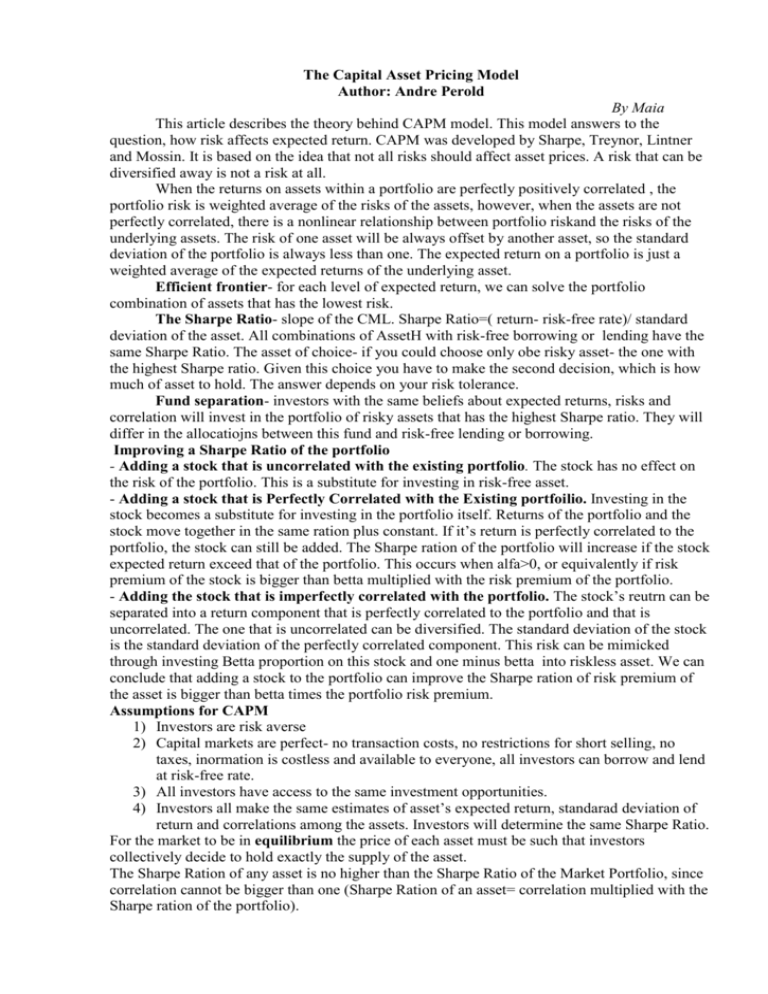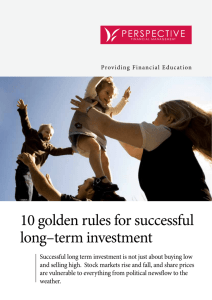The Capital Asset Pricing Model
advertisement

The Capital Asset Pricing Model Author: Andre Perold By Maia This article describes the theory behind CAPM model. This model answers to the question, how risk affects expected return. CAPM was developed by Sharpe, Treynor, Lintner and Mossin. It is based on the idea that not all risks should affect asset prices. A risk that can be diversified away is not a risk at all. When the returns on assets within a portfolio are perfectly positively correlated , the portfolio risk is weighted average of the risks of the assets, however, when the assets are not perfectly correlated, there is a nonlinear relationship between portfolio riskand the risks of the underlying assets. The risk of one asset will be always offset by another asset, so the standard deviation of the portfolio is always less than one. The expected return on a portfolio is just a weighted average of the expected returns of the underlying asset. Efficient frontier- for each level of expected return, we can solve the portfolio combination of assets that has the lowest risk. The Sharpe Ratio- slope of the CML. Sharpe Ratio=( return- risk-free rate)/ standard deviation of the asset. All combinations of AssetH with risk-free borrowing or lending have the same Sharpe Ratio. The asset of choice- if you could choose only obe risky asset- the one with the highest Sharpe ratio. Given this choice you have to make the second decision, which is how much of asset to hold. The answer depends on your risk tolerance. Fund separation- investors with the same beliefs about expected returns, risks and correlation will invest in the portfolio of risky assets that has the highest Sharpe ratio. They will differ in the allocatiojns between this fund and risk-free lending or borrowing. Improving a Sharpe Ratio of the portfolio - Adding a stock that is uncorrelated with the existing portfolio. The stock has no effect on the risk of the portfolio. This is a substitute for investing in risk-free asset. - Adding a stock that is Perfectly Correlated with the Existing portfoilio. Investing in the stock becomes a substitute for investing in the portfolio itself. Returns of the portfolio and the stock move together in the same ration plus constant. If it’s return is perfectly correlated to the portfolio, the stock can still be added. The Sharpe ration of the portfolio will increase if the stock expected return exceed that of the portfolio. This occurs when alfa>0, or equivalently if risk premium of the stock is bigger than betta multiplied with the risk premium of the portfolio. - Adding the stock that is imperfectly correlated with the portfolio. The stock’s reutrn can be separated into a return component that is perfectly correlated to the portfolio and that is uncorrelated. The one that is uncorrelated can be diversified. The standard deviation of the stock is the standard deviation of the perfectly correlated component. This risk can be mimicked through investing Betta proportion on this stock and one minus betta into riskless asset. We can conclude that adding a stock to the portfolio can improve the Sharpe ration of risk premium of the asset is bigger than betta times the portfolio risk premium. Assumptions for CAPM 1) Investors are risk averse 2) Capital markets are perfect- no transaction costs, no restrictions for short selling, no taxes, inormation is costless and available to everyone, all investors can borrow and lend at risk-free rate. 3) All investors have access to the same investment opportunities. 4) Investors all make the same estimates of asset’s expected return, standarad deviation of return and correlations among the assets. Investors will determine the same Sharpe Ratio. For the market to be in equilibrium the price of each asset must be such that investors collectively decide to hold exactly the supply of the asset. The Sharpe Ration of any asset is no higher than the Sharpe Ratio of the Market Portfolio, since correlation cannot be bigger than one (Sharpe Ration of an asset= correlation multiplied with the Sharpe ration of the portfolio). A high Beta Stock will have a high stand-alone risk, but a stock need not have a high beta to have a high stand- alone risk. Beta of the portfolio is the weighted average of the betas of the stock in the portfolios. All assets must lie on the Securities Market Line. Not all of the stand-alone risk of an asset is priced into its expected return, just that portion of the risk that is correlated with the market portfolio.Stock’s expected return does not depend on the growth rate of its expected future cash flows. In order to know the return, we need to know Betta, according to CAPM. Is the CAPM useful? - Suboptimal diversification ( not all investors hold the same portfolio). There is also a home bias in international investing. In almost all countries, foreign ownership of assets is low, meaning that investors tend to hold predominantly home country assets. - Performance measurement. Investors need to assess performance based on returns that have been appropriately risk adjusted. - Even if it does not perfectly describe the current world, it still might predict future investor behaviour. - This is a benchmark for undestanding capital market phenomena. Extensions of the CAPM- International CAPM. Investors care about the main risk factormarket and are also concerned about real currency fluctuations. Size cannot be a risk factor that affects return, since small firms would then just combine and form big firms. MAIN IDEA: The CAPM tells us that ownership of assets by diversified investors lowers their expected returns and raises prices. Moreover, investors, who hold undiversified portfolios are likely to be taking risks for which they are not being paid. The Capital Asset Pricing Model Perrold The cost of equity capital in the past was calculated: Return = (Dividend per share/Price per share) + Div. growth rate From the perspective of modern finance, this is wrong as cost of capital (assets) determine cost of equity, not vice versa. Adding the asset that perfectly positively correlates with other asset will not diversify away unique risk. This is the same as investing in portfolio itself. (!) International diversification is not optimal nowadays. Investors prefer to hold more home country assets because it is cheaper in terms of taxes and direct expenses but they do not pay much attention to the fact that broad international diversification can reduce unique risk up to 90 per cent. In order to compare fund performance, we need to adjust portfolios for market risk. Achieve high return with high beta (risk) for assets is easier, but to get high return with low asset beta is much harder and requires a lot of skills. (!) Modifying assumptions of CAPM will lead to appearance of new terms to hold equilibrium. Example: International CAPM which should include betas/risk for currency movements and other risks that are viewed differently by different investor segments.





